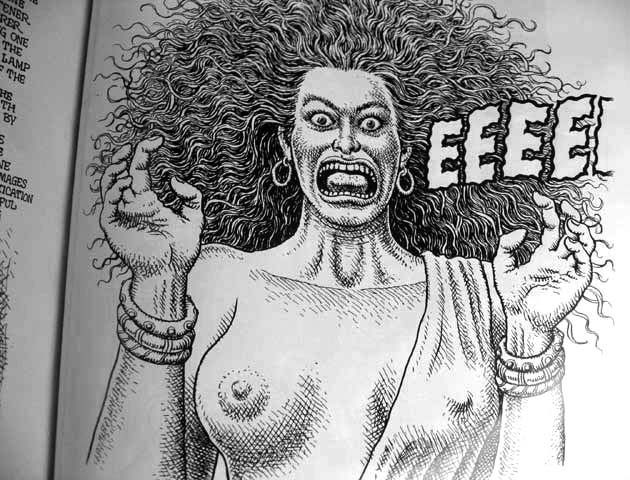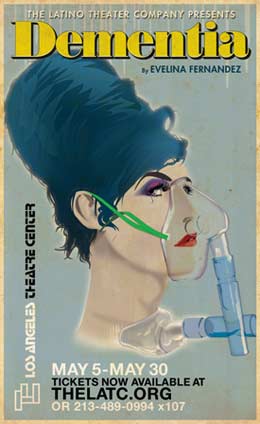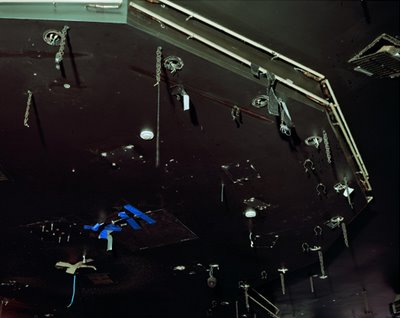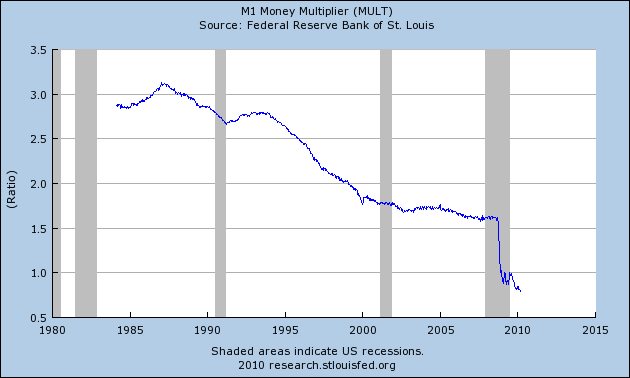How many performance artists does it take to change a light bulb? I don’t know, I had to leave after four hours.

{ Identity chip implanted into man gets computer virus | BBC video | Illustration: R. Crumb }

{ Identity chip implanted into man gets computer virus | BBC video | Illustration: R. Crumb }
When the Conficker computer “worm” was unleashed on the world in November 2008, cyber-security experts didn’t know what to make of it. It infiltrated millions of computers around the globe. It constantly checks in with its unknown creators. It uses an encryption code so sophisticated that only a very few people could have deployed it. For the first time ever, the cyber-security elites of the world have joined forces in a high-tech game of cops and robbers, trying to find Conficker’s creators and defeat them. The cops are failing. And now the worm lies there, waiting…
{ The Atlantic | Continue reading | Thanks Daniel }
quote { via Orion Magazine }
{ A Jefferson County teacher picked the wrong example when he used assassinating President Barack Obama as a way to teach angles to his geometry students. Someone alerted authorities and the Corner High School math teacher was questioned by the Secret Service, but was not taken into custody or charged with any crime. | Alabama Live | full story }
I myself spent nine years in an insane asylum and i never had the obsession of suicide, but i know that each conversation with a psychiatrist, every morning at the time of his visit, made me want to hang myself, realizing that i would not be able to cut his throat. (…)
…and what is an authentic madman? It is a man who preferred to become mad, in the socially accepted sense of the word, rather than forfeit a certain superior idea of human honor. So society has strangled in its asylums all those it wanted to get rid of or protect itself from, because they refused to become its accomplices in certain great nastinesses. For a madman is also a man whom society did not want to hear and whom it wanted to prevent from uttering certain intolerable truths. (…)
…no one has ever written, painted, sculpted, modeled, built, or invented except literally to get out of hell.
{ Antonin Artaud, Van Gogh: The Man Suicided by Society, 1947 }
The return from Ireland brought about the beginning of the final phase of Artaud’s life, which was spent in different asylums. When France was occupied by the Nazis, friends of Artaud had him transferred to the psychiatric hospital in Rodez, well inside Vichy territory, where he was put under the charge of Dr. Gaston Ferdière. Ferdière began administering electroshock treatments to eliminate Artaud’s symptoms, which included various delusions and odd physical tics. The doctor believed that Artaud’s habits of crafting magic spells, creating astrology charts, and drawing disturbing images, were symptoms of mental illness. The electro-shock treatments have created much controversy, although it was during these treatments — in conjunction with Ferdière’s art therapy — that Artaud began writing and drawing again, after a long dormant period. In 1946, Ferdière released Artaud to his friends, who placed him in the psychiatric clinic at Ivry-sur-Seine. Current psychiatric literature describes Artaud as having schizophrenia, with a clear psychotic break late in life and schizotypal symptoms throughout life.
Artaud was encouraged to write by his friends, and interest in his work was rekindled. He visited an exhibition of works by Vincent van Gogh which resulted in a study Van Gogh le suicidé de la société [Van Gogh, The Man Suicided by Society], published by K éditeur, Paris, 1947 which won a critics´ prize.
In January 1948, Artaud was diagnosed with intestinal cancer. He died shortly afterwards on March 4, 1948, alone in the psychiatric clinic, seated at the foot of his bed, allegedly holding his left shoe.

I woke up one day and everything in the apartment had been stolen and replaced with an exact replica. I said to my roommate, ‘Can you believe this? Everything in the apartment has been stolen and replaced with an exact replica.’ He said, ‘Do I know you?’
photo { Johan Willner }

Giant ice sheets in Antarctica behave like mirrors, reflecting the sun’s energy and moderating the world’s temperatures. The waxing and waning of these ice sheets contribute to changes in sea level and affect ocean circulation, which regulates our climate by transporting heat around the planet.
Despite their present-day cold temperatures, the poles were not always covered with ice. New climate records recovered from Antarctica during the recent Integrated Ocean Drilling Program (IODP) “Wilkes Land Glacial History” Expedition show that approximately 53 million years ago, Antarctica was a warm, sub-tropical environment. During this same period, known as the “greenhouse” or “hothouse” world, atmospheric CO2 levels exceeded those of today by ten times.
Then suddenly, Antarctica’s lush environment transitioned into its modern icy realm. In only 400,000 years — a mere blink of an eye in geologic time — concentrations of atmospheric carbon dioxide decreased. Global temperatures dropped. Ice sheets developed. Antarctica became ice-bound.
How did this change happen so abruptly and how stable can we expect ice sheets to be in the future?
To answer these questions, an international team of scientists participating in the Wilkes Land Glacial History Expedition spent two months aboard the scientific research vessel JOIDES Resolution in early 2010, drilling geological samples from the seafloor near the coast of Antarctica. Despite negotiating icebergs, near gale-force winds, snow, and fog, they managed to recover approximately 2,000 meters (over one mile) of sediment core.
photo { Alessandro Zuek Simonetti }

Two years ago, a police officer in a Brooklyn precinct became gravely concerned about how the public was being served. To document his concerns, he began carrying around a digital sound recorder, secretly recording his colleagues and superiors.
He recorded precinct roll calls. He recorded his precinct commander and other supervisors. He recorded street encounters. He recorded small talk and stationhouse banter. In all, he surreptitiously collected hundreds of hours of cops talking about their jobs.
Made without the knowledge or approval of the NYPD, the tapes—made between June 1, 2008, and October 31, 2009, in the 81st Precinct in Bedford-Stuyvesant and obtained exclusively by the Voice—provide an unprecedented portrait of what it’s like to work as a cop in this city.
illustration { Stuart Patterson }

A collection of paintings that have caused art aficionados to turn a deep shade of purple and have provoked upset and anger throughout the art world are to go on show.
The forged works include a fake Botticelli, which was bought for a higher price than a genuine work by the artist sold at the same time. A gallery director almost had to resign because of another one, a fake Holbein.
In an unprecedented spirit of public transparency (and perverse pride), the National Gallery in central London is dusting down its holdings of forged paintings, accidentally bought as genuine works, supposedly by Botticelli, Holbein and Durer, among others, and showing them off to the public.
Some experts within the gallery actually prefer the fakes to the real thing, they revealed yesterday. Rachel Billinge, a research associate in the gallery’s conservation department, said she sometimes looked upon the forgeries with more admiration than the works by their genuine counterparts. “Sometimes you can appreciate their techniques, and the effort they put in, more than the original that was churned out by a bored apprentice at a workshop,” she said.
The last known fake bought by the gallery was in the late 1950s, when it acquired a painting believed to be a genuine Rembrandt, An Old Man in an Armchair. Signed and dated falsely, many curators have marvelled at its extraordinary technique and artistic achievement.
Mobile Phone Harrassment: An exploration of students’ perceptions of intrusive texting behavior
Limited research has explored the link between mobile phone use and harassment behaviors. This paper details the findings from a preliminary study that examined perceptions of unwanted communication. (…)
Findings indicated that harassment by text is more prevalent than other forms of off-line stalking and, despite recipients reporting being distressed, there was still a higher level of acceptance of this form of harassment than other forms.
Furthermore, responses to text harassment were associated with a high frequency of behaviors perceived as not actively discouraging further texts, therefore having the effect of prolonging unwanted contact.
Goldman Sachs Group Inc was charged with fraud by the U.S. Securities and Exchange Commission over its marketing of a debt product tied to subprime mortgages that was designed to fail.
The lawsuit is the biggest crisis in years for Goldman, which emerged from the global financial crisis as Wall Street’s most influential bank. (…)
The SEC alleged that Paulson & Co, a major hedge fund run by billionaire John Paulson, worked with Goldman in creating a collateralized debt obligation, and stood to benefit as its value fell, costing investors more than $1 billion. That is roughly the amount that Paulson is estimated to have made by betting against the CDO.

When pain is pleasant
Ever prodded at an injury despite the fact you know it will hurt? Ever cook an incredibly spicy dish even though you know your digestive tract will suffer for it? If the answers are yes, you’re not alone. Pain is ostensibly a negative thing but we’re often drawn to it. Why?
According to Marta Andreatta from the University of Wurzburg, it’s a question of timing. After we experience pain, the lack of it is a relief. Andreatta thinks that if something happens during this pleasurable window immediately after a burst of pain, we come to associate it with the positive experience of pain relief rather than the negative feeling of the pain itself. The catch is that we don’t realise this has happened. We believe that the event, which occurred so closely to a flash of pain, must be a negative one. But our reflexes betray us.
Andreatta’s work builds on previous research with flies and mice. If flies smell a distinctive aroma just before feeling an electric shock, they’ll learn to avoid that smell. However, if the smell is released immediately after the shock, they’re actually drawn to it. Rather than danger, the smell was linked with safety. The same trick works in mice. But what about humans?
quote { Charles Baudelaire, The Man Who Tortures Himself, 1857 }

Did you hear about the Bangladeshi brick company that beheaded an employee to improve the color of its bricks?
This tragic incident raises many questions. The article is vague, but I assume a supervisor or some sort of boss was leading this strategy. So I wonder how the employee was chosen? Was he the worst worker, the biggest complainer, or the guy who looked the most like a brick? (…)
I wonder how the boss broke the news to the employee. Did he work up to it with a list of criticisms about the employee’s job performance? As a boss, you don’t want to start that sort of conversation with the beheading part. Begin with something like “I noticed you’ve been late twice this week.” That way it isn’t such a cruel shock when you get to the decapitation scenario.

Black holes may constitute all dark matter
Dark matter is the mysterious stuff that cosmologists believe fills our Universe. The evidence for its existence is that there is not enough visible mass to hold galaxies together. But since galaxies manifestly do not fly apart, there must be some invisible stuff, some missing mass, that generates the gravitational forces holding them together.
But there’s a problem with this idea. Two of them actually. First, physicists’ best guess at the laws of physics give a good description of all of the particles they’ve discovered so far and a few they expect to discover soon. The trouble is that none of these particles have the right kind of properties to be dark matter ie electrically neutral, long-lived and slow moving. But none of the known or reasonably hypothesised particles fits the bill. To make room for a dark matter particle, the laws of physics have to be changed in ways that many theorists feel uncomfortable with.
Second, despite a decade spent searching for dark matter with experiments costing tens of millions of dollars, nobody has laid eyes on the stuff. Most physicists think these experiments have found nothing: zip, zilch, zero.
photo { Nick Waplington, S-M Club Ceiling, 2004 }

{ Wound Man is an illustration which first appeared in European surgical texts in the Middle Ages. It laid out schematically the various wounds a person might suffer in battle or in accidents, often with surrounding or accompanying text stating treatments for the various different injuries. | Wikipedia | Continue reading }
“Perhaps most troubling,” says the report, “the FBI could not determine in many cases whether the lost or stolen laptop computers contained sensitive or classified information. Such information may include case information, personal identifying information, or classified information on FBI operations.” Laptops can also contain goodies like the software that the FBI uses to make its identification badges, a copy of which was installed on a laptop stolen from the Boston Field Office in July 2002.
In the 44 months that it took to complete the new audit, the FBI lost 160 weapons and 160 laptop computers—a massive improvement over the 354 weapons and 317 laptops lost during the first 28-month-long audit. In any organization the size of the FBI, equipment is going to be lost, misplaced, or stolen, so perfection is not to be expected.

{ Barron’s notes that the M1 money multiplier biweekly indicator is worth watching closely. | Barry Ritholtz | Continue reading }